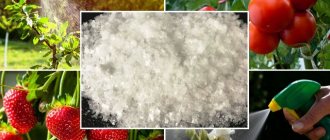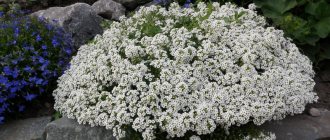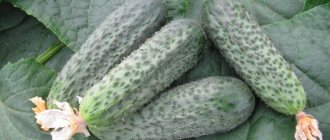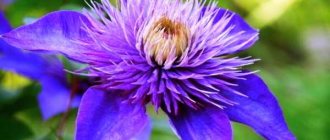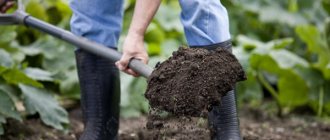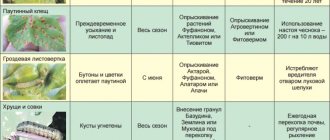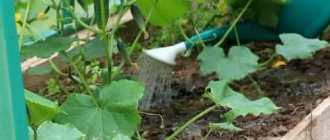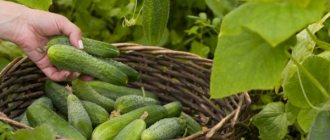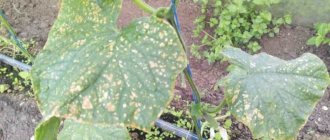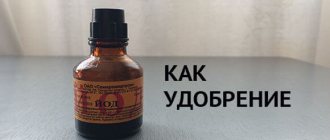The effect of boric acid on cucumbers
Boron is a substance that is one of the most important components of most fertilizers used. It can be used not only for cucumbers, it perfectly nourishes many other crops: cabbage, tomatoes, peppers, etc. Boron is part of the cells of all vegetative parts of plantings. So, why is boric acid so good for cucumbers?
Improved photosynthesis
Photosynthesis plays an important role in plant life. It requires sufficient light and air. The essence of the process is the absorption of carbon dioxide and the release of oxygen.
Without photosynthesis it is impossible to obtain a full harvest. During the day, the vegetative parts of the plantings actively absorb solar energy and breathe, so that at night they begin to grow intensively and fill up.
Stimulating growth
With the classic scheme for growing cucumbers, ovaries form on the bushes by July. If there are few of them, they appear extremely reluctantly, then they speak of a slowdown in the growth of plantings. If there are no signs of serious diseases, then spraying with boric acid will help speed up the development process of cucumbers.
Boosting immunity
Due to its antiseptic properties, boric acid is widely used to destroy harmful microorganisms that can parasitize leaves or stems. Spraying helps prevent the development of many diseases and strengthens the immunity of plantings, which develop resistance to pathogenic microorganisms.
Enlargement of ovaries
The main goal of any gardener is to get a rich harvest. This cannot be achieved if too few ovaries are formed. Spraying the plantings with boric acid will help increase their number. Often, a deficiency of ovaries occurs in polycarbonate greenhouses, where insufficient sunlight penetrates. If the sun is too active, then this fact can also have a detrimental effect on cucumbers, causing sunburn on the leaves and stem.
Treating plantings with fertilizers that contain boron stimulates the formation of new female flowers, which, in turn, increases the number of ovaries. In addition, boric acid activates the formation of roots, strengthens the root system, and also increases the concentration of sugar, which improves the taste of the harvest.
Strengthening the roots
Cucumbers have a tap root system, the main root of which can go 1 meter deep into the bed. This structure allows you to receive nutrients that are located where the roots of other plants do not reach.
Boric acid stimulates the growth of the root system, so the plantings receive more vitamins and minerals. This has a beneficial effect on all parts of the plant: the stem grows, many female flowers appear, the ovaries are formed in sufficient quantities, the fruits are full. From such a bush you will reap not only a large, but also a very tasty harvest.
Read the article about how to grow cucumbers on the balcony and windowsill.
The benefits and harms of boric acid
Boron is a drug that affects the production of hormones in plants. It helps in the absorption of necessary calcium and is directly involved in the construction of cells.
Boric acid powder - a universal remedy
The use of powder helps improve the growth of cucumbers and increases the yield of treated plantings several times. With the help of boric acid, summer residents carry out disinfection and protective measures in the greenhouse or in the garden.
For your information! Fertilizer should be applied from the moment the first leaves appear on the seedlings. This will increase the number of ovaries.
Fertilizing also promotes better absorption of nitrogen fertilizers. Productivity increases, immunity is strengthened, and the plant can more easily tolerate unpleasant weather conditions.
Treatment of cucumbers with boric acid is carried out in open ground in the absence of wind. It is also important to understand that the use of any medications is allowed only in the evening or early morning.
Healthy cucumber seedlings
The use of boron fertilizer does not have negative consequences either for humans or for the crop itself. The only thing that can happen due to an excess of this element is the seedling being burned and, as a consequence, the shoots dying and falling off.
Important! The use of any product requires adherence to precise dosages.
How to determine boron deficiency in cucumbers
Boron is not washed out of plants; its indicator is a fixed value. If a plant is deficient in this element, this can be understood by several manifestations.
Slow growth
With a lack of boron, growth slows down. The bush looks healthy, but stands out against the background of the garden bed with its modest size; there are very few ovaries and flowers on it, so you won’t get a rich harvest from such a planting.
Appearance of leaves
The leaf blade stops developing and is distinguished by its dwarf size. If there is not enough boron, the leaves may begin to turn pale and yellow. The immunity of the plantings is reduced, so the surface of the leaves becomes vulnerable to late blight, which is why brown spots appear on them.
If you notice that, in the absence of signs of disease, the leaves begin to curl and stop growing altogether, you need to fertilize the plants with fertilizers that contain boron.
Yellow border
Often the main reason for yellowing in the form of a border on a leaf plate is a lack of moisture and a low concentration of macro- and microelements in the soil. To compensate for the lack of nutrients, you can water with a specially prepared solution with boric acid; this measure will strengthen the immune system and normalize metabolic processes.
Weak flowering
There are many factors that can reduce the number of flowers on a bush. But all of them affect the planting only when its immunity cannot cope with the harmful influence from the outside.
Treatment with boric acid will help increase the resistance of cucumbers even in cases of violation of agrotechnical growing rules, when:
- watering is carried out with cold water (it must certainly be pre-heated, for example, in the sun),
- the plants are planted too densely and the distance between the bushes is less than 50 cm (exceptions are those cucumbers for which this value may be different due to the characteristics of the variety),
- the shift was not pre-treated or low-quality seed was used (some purchased seeds are already pre-treated by the manufacturer, which will be indicated on the packaging),
- the plantings were not fed on time or the fertilizers applied were not enough.
Bad ovary
Often gardeners are faced with the problem that many flowers appear on a bush, they fall off, and the ovaries do not form. This phenomenon is sometimes caused by boron deficiency.
Increased susceptibility to disease
There are a great many diseases in cucumbers. Due to the negative influence of weather conditions, parasites, and insects, spots, ulcers, necrosis and other defects may appear. The lower the bush’s immunity, the faster it will succumb to the harmful influence of parasites. Treatment with boric acid helps strengthen the immune system and increase resistance to disease.
What does boron deficiency cause in plants?
In addition to the main nutrients - nitrogen, potassium and phosphorus - garden crops need microelements. It is impossible to say which one is more important, since each is responsible for certain functions. Boron is one of the many elements thanks to which the plant develops fully. Its presence in the soil allows vegetable crops to correctly form inflorescences and set fruit.
If there is a deficiency of this component, the top dies off. Consequently, the vegetable crop does not grow to the required size and cannot set fruit. If a deficiency occurs at a time when the ovary has already formed, then it crumbles, leaving the owner of the plot without a harvest.
The trace element affects the quality and quantity of pollen, which affects the number of ovaries. Carbohydrate and protein metabolism completely depends on the absorption of boron.
In case of its absence or drought, the color of the leaves changes from green to red or bronze. Dark spots may appear on tomatoes and cucumbers, which will lead to a decrease in shelf life. Damaged fruits cannot be canned, as they will be unsuitable for food.
Most often, boron starvation is observed on calcareous soils, which have a high alkali content. Plants cannot absorb it in undissolved form, so another condition is moderate humidity. Wetland soils are also poor in micronutrients.
Both normally developing plants and those with malnutrition can grow in one area. If the bed is located in a lowland where water accumulates, then you may not expect a good harvest from it.
How to determine excess boron in cucumbers
For cucumber plantings, not only boron deficiency is dangerous, but also its excess content. It can be recognized by the following external signs:
- Among the flowers, male flowers predominate, so very few ovaries are formed;
- leaves grow slowly, young growth practically does not develop;
- the surface of the leaf plate is framed by a yellow border.
Important! It is very easy to compensate for boron deficiency with appropriate fertilizing, but dealing with excess is much more difficult due to the fact that boron is extremely reluctant to leave plant cells. Therefore, it is so important to use fertilizers wisely and apply fertilizers strictly in accordance with the recommendations of specialists.
Signs of excess or deficiency of boron
A lack of such an important element in the soil as boron can lead to extremely negative consequences:
- at the initial stage, the leaves of the seedling change, their structure becomes rough;
- plant growth stops;
- internodes and side shoots practically stop growing;
- female flowers fall off, cucumber production stops;
- at a critical level of boron starvation, the fruits take on a curved appearance;
- the vegetable turns white and takes on an unhealthy appearance;
- The upper leaves of the cucumber suddenly turn yellow, and the bush develops chlorosis.
External signs of boron deficiency
If the plant is oversaturated with boron, its health also worsens. External excess criteria:
- curling of the leaves down is the first sign;
- the color of the leaf blade changes, it takes on a lemon tint;
- an overfed plant differs from its neighbors - it lags behind in growth and formation;
- an excess of boron at a late stage causes necrosis of the green mass.
Signs of excess boron on a plant
The use of boric acid at different stages of cucumber development
Of course, boron fertilizers are very useful for cucumbers. But they need to be applied in doses; this is done no more than three times per season. Otherwise, excess boron may occur, which will be very difficult to correct.
Seeds
Pre-sowing preparation of cucumbers involves treating the seeds and fertilizing the soil. All seed must be soaked in a weak solution of potassium permanganate for 20-40 minutes. After this, it is recommended to dip the seeds in boron liquid (2 mg per 1 liter of water). To do this, they are wrapped in a small gauze bag and placed in a glass with this substrate for about 60 minutes. This measure increases their viability and kills harmful microorganisms that may be present in them.
Important! When preparing solutions with boric acid, you need to remember that it is correct to add it only to hot water; it practically does not dissolve in cold water.
Seedling
Any work with seedlings is carried out only when 3-4 full leaves appear on the stems. It is recommended to treat young cucumbers with boric acid once; no more is needed to prevent its excess. To prepare a solution, add 3 g of boric acid to 1 liter of boiling water, stir and cool. After this, the concentrate is poured into a 10-liter bucket of water; it is strictly forbidden to use it for watering in its pure form.
The resulting solution can be used both for spraying plants and for fertilizing the soil. It will strengthen the root system, accelerate the growth of seedlings, and help them adapt faster after planting in open ground or a greenhouse.
During flowering and fruit set
It is very important to support plants during the flowering stage; the formation of female flowers, which subsequently produce ovaries, directly depends on the amount of nutrients. A solution of boric acid can be combined with fertilizers containing iodine, ash or even brilliant green. Many gardeners use boric acid to speed up pollination processes. This is especially true for those cucumbers that are planted in open ground. Instructions for preparing bait for pollinating insects: add 4 tbsp of sugar to a basic boron solution (2 g per 1 l). They spray the bushes. Bees stimulate pollination, and boron will help the ovaries become stronger and grow faster.
Timely fertilizing with boron during the flower formation period can lead to an increase in the number of cucumbers collected from one bush by 30%.
Fruiting
The fruiting period for cucumbers begins in the second half of July and can last until the end of August. The plant spends all its energy on the formation of fruits, so it is so important to support it at this stage. Boron supplements will help do this. A pleasant bonus from this procedure will be the excellent aroma and unsurpassed taste of the collected cucumbers.
It is best to give adult bushes root feeding; they need to be combined with watering, which is carried out first. Next, the soil is spilled with boron solution. It is diluted in the same way as for spraying.
Boron for bee-pollinated cucumbers
Varieties and hybrids of cucumbers in open ground are most often bee-pollinated. Experienced summer residents recommend an original recipe for foliar feeding during flowering using sugar and boric acid.
Sweet foliar feeding attracts insects, pollination improves, and the number of fruits increases. The yield in cucumber beds after using this fertilizer increases by 20 percent.
One 10 g pack requires 5 liters of water and 500 g of sugar. First dissolve sugar and acid in 0.5 liters of hot water, bring to full volume after they are completely dissolved. The use of sweet fertilizer makes sense not only for cucumbers - it is also useful for zucchini.
Preparation of a solution from boric acid
There is absolutely no wisdom in preparing a boron solution. The most important thing is to follow the dosage of the substance. When choosing boric acid, you need to know that only powder is suitable for preparing fertilizer; an alcohol solution should never be used.
Important! If the concentration of boric acid is exceeded, chemical burns may appear on the vegetative parts after spraying.
It is not recommended to store the solution; it should be used immediately after preparation.
Solution proportions
The recommended amount of boric acid for fertilizer is no more than 5 g (about 1 tsp) per 10 liters of water. If you want to prepare a smaller volume of fertilizer, then you need to prepare it at the rate of 0.5 g per liter.
How to get rid of ants using boric acid
Ants often live in cucumber beds. Insects especially love to settle in greenhouse beds fenced with boards. It is very difficult to destroy them. There are good boric acid bait recipes that can help reduce insect populations.
For bait, prepare a sweet solution:
- 100 ml water;
- 5 g acid;
- 1 tsp jam;
- 2 tbsp. l sugar.
Heat the water and add all the ingredients to it. Pour the resulting liquid into a container. Place it on a cucumber bed and cover it loosely with a tire.
You can prepare dry bait in the form of balls. Make it from boiled potatoes (3 pcs.), yolks of boiled eggs (3 pcs.), 10 g of boric acid. Mix all ingredients thoroughly to obtain a homogeneous mass. Form small balls out of it and place them in places where ants gather.
The use of boric acid for feeding cucumbers with additives (table)
Boric powder
Potassium permanganate Ammonia solution
From a nematode
Milk
Iodine
Chlorella
Ash
Zelenka
| Cooking diagram | Purpose of use | Rules of application |
After dissolving the substance, another 10 liters of liquid are added to the concentrate. | Increase the stability of young plantings. | Seedlings must be sprayed at the rate of 30 ml per bush immediately after planting in the garden. |
All ingredients must be dissolved in warm water, then add 10 liters of water. | Attract insects to improve natural pollination. | Treatment is carried out at the flowering stage, for 1 sq. m, 100 ml of solution is enough. |
Mix the ingredients in warm water, after which the substrate is diluted in 10 liters of cold water. | Activate flowering, accelerate the formation of female flowers, increase resistance to aphids and fungi. | The bushes are sprayed at the stage of bud formation; 50 ml of solution is enough for each plant. |
Dissolve the acid in warm water, then add the remaining components and dilute the substrate with 9 liters of water. | Accelerates the growth of vegetative parts, promotes the formation of ovaries, increases resistance to various types of fungus. | Serum treatment is carried out before flowers begin to appear. The solution consumption per 1 sq.m is 100 ml. |
Boron powder is dissolved in water, chlorella is diluted into a liter of water in a separate container, after which these two concentrates are mixed with each other and diluted with an additional 10 liters of water. | Increases the immunity of plantings, strengthens them and increases resistance to fungi. | During the flowering period, as well as at the stage of formation of ovaries and fruits, the bushes are sprayed with the solution at the rate of 50 ml for each. |
Recipe 1:
Recipe 2:
Recipe 3, concentrated:
Bring the water to a boil, pour in the ash, boil a little more, then add the remaining ingredients and leave for a day to infuse. In this way, we obtain a concentrate that absolutely cannot be used in its pure form. For processing, it is diluted with water in proportions of 1:10. | Improves growth and accelerates the development of plantings, has an antiseptic effect, and increases resistance to infections. | All recipes are intended for root watering of plants. The first is used when 3-4 full-fledged leaves appear on the plant, the second - before the flowers appear, the third (concentrated) - when the ovaries and first fruits appear on the bushes. |
| Increases resistance to powdery mildew and has an antifungal effect. | The solution is used both for processing tomatoes and cucumbers, which is carried out before the first ovaries appear. |
Reference. To prepare a disinfectant solution, you can dilute 5 drops of iodine in 200 ml of milk. | Improves the health of plantings and increases their immunity. | Used at different stages of growth up to 3 times per season. |
Other recipes with various additives
This foliar feeding has many preparation options with different properties. To attract pollinating insects, just dilute one hundred grams of honey or sugar in ten liters of water and spray cucumbers with the resulting colloid. This method will speed up cross-pollination of seedlings, which will lead to early fruiting.
Popular formulations:
- To protect your plantings from various diseases, such as leaf mosaic, powdery mildew rot, you can feed the plants with a mixture of boric acid with a solution of potassium permanganate and iodine. Manganese has antiviral properties, which makes it extremely useful in the garden. Preparation method: mix a tablespoon of boron with 10 liters of water and add a little potassium permanganate and 40 drops of Lugol's solution (pharmacy iodine). Treatment with such a drug can be both systematic and therapeutic.
- To combat aphids and pathogens, plantings can be treated with a special recipe. To prepare, you need to mix half a teaspoon of the drug with two tablespoons of ammonia (sold in pharmacies as ammonia) and add a little potassium permanganate. It is necessary to process at the bud stage, fifty milliliters per plant.
- You can increase the strength of the fertilizer by mixing one and a half grams and several crystals of potassium permanganate in two hundred milliliters of hot water. The resulting mixture should be diluted in a glass of milk, add 60 drops of iodine and one tablespoon of urea. Bring the volume to ten liters by mixing with cold water. Treatment with this composition increases immunity to fungal diseases and significantly accelerates growth. Watering costs about one hundred milliliters per cubic meter of land.
Note!
If you mix two drops of ordinary pharmaceutical greens with 0.2 grams of boron powder in a liter of water and spray the seedlings before they begin to ripen, you can reduce the risk of infection with powdery mildew and late blight.
The fact is that the brilliant green solution has antiseptic properties and protects the sprouts, stimulating the appearance of the ovary. All fertilizing with boron must be done systematically, otherwise there will simply be no effect.
How to treat cucumbers with boric acid
Boron, of course, is present in the soil itself even before fertilizing begins, but together with its salts, this substance is easily washed out with precipitation and watering. Therefore, fertilizing is most often carried out by spraying the bushes. This is done 3 times per season: at the stage of bud appearance, during the flowering period and during active fruit formation.
There are three rules that must be followed when planning to fertilize with boron:
- processing is carried out exclusively in calm and dry weather,
- plants are sprayed early in the morning or evening,
- the entire surface of the sheet plate should be moistened evenly on both sides.
Figures confirm the benefits of boron for cucumbers
Talk about the benefits of boron has practical confirmation. The proof is the positive reviews of summer residents, which are easy to find on the Internet. This is also proven by field tests carried out by specialists. Scientists grew two groups of cucumbers of the same variety. Some cucumbers were fed with boric acid, others were not.
In the group of cucumbers that were sprayed with boric acid, the indicators of the analyzed parameters turned out to be several times higher. The data is shown in the table.
| Parameter | Excess factor |
| the volume of vegetative mass of one bush during the flowering period | 1,58 |
| dry matter content | 1,3 |
| weight of fruits collected from one bush | 1,16 |
Features of the use of boric acid for cucumbers
Boron powder can be used both for spraying and watering cucumbers. There are many recipes for feeding, which differ in the concentration and composition of the ingredients.
From pests
Boric acid is a toxic substance for many insects: ants, slugs, cockroaches and others. Once in the pest's stomach, it triggers irreversible destructive processes that invariably lead to the death of the insect.
If your beds are attacked by a colony of ants, dilute boron powder in warm water at the rate of 1 g per 1 liter. To make it more attractive to insects, add a little sugar syrup or honey. This solution should be used to water anthills or inter-ridge passages.
To attract bees
For cucumbers that do not have the ability to self-pollinate, bees are very important. Only with their participation will female flowers be formed and ovaries formed. To attract insects, cucumbers can be sprayed with a boric solution, which is prepared by adding 2 g of boric acid to 1 liter of warm water.
When the substance is completely dissolved, the concentrate is diluted with an additional 7 liters of water. There you need to add 1 tbsp. Sahara. Boric acid in the fertilizer will strengthen the immune system and accelerate the growth of plantings, and the sweet smell will attract insects, which will speed up the pollination process.
To prevent mineral deficiency
If there is a deficiency of macro- and microelements in the soil, root watering is necessary. To prepare it you will need 10 g of boron powder, which is diluted in 10 liters of warm water.
Preparation for planting and watering
May be interesting Characteristics and features of growing cucumber “Farmer f1” Yellow spots on cucumber leaves: how and with what to treat Cucumber bacteriosis or angular leaf spot: methods of treatment and prevention
The wonderful properties of the substance do not end there; it is also used to disinfect the germs of future crops. This prevention helps:
- avoid problems with green plantations in summer;
- seeds germinate earlier.
You just need to keep the seeds for twelve hours in a solution of one gram of acid per liter of water and plant them.
In order for the seedlings to take root better, you can fertilize it before adding planting material to the soil. To prepare the useful substance, you need to infuse onion peels in a small amount of water and mix the resulting solution with ash. The mixture should be added to the soil a few days before planting cucumbers.
To get the maximum effect from boric acid, you should apply a few simple rules and principles for spraying:
- The first watering of boric acid on cucumbers should be done after the crop has produced at least four true leaves.
- It is best to feed cucumbers with boric acid a second time at the budding stage or at the beginning of flowering. If the crop is not self-pollinating, then add sugar or honey.
- The crop should be watered a third time during the formation of ovaries in order to supply the plant with the necessary nutrients.
- In the case of cultivation on sand or peat bogs, you can apply a fourth feeding, using half the usual dose of boric acid per bucket of water.
- The water temperature for irrigation should be around +25°C, otherwise rot may form.
Along with boron, superphosphate and ash can be added to the soil to get the best effect. It is worth spraying on the leaves from the top and bottom sides to prevent fungus from forming in the shade of the shoot, and distribute the solution evenly. It is necessary to take into account the fact that seedlings are not able to store the substance, so it is important not to forget to apply it on time.
Note!
Boric acid can seriously speed up the process of fruit formation, since most often cucumbers in gardens are cross-pollinated, and bees are carriers of pollen.
To attract these beneficial insects, it is enough to use a foliar feeding recipe with honey or sugar. To prepare, combine ten grams of bromic acid with five hundred grams of honey or sugar in five liters of water. When irrigated with this solution, the yield increases by twenty percent.
General rules for using boric acid for feeding cucumbers in open ground
Often, the soil in the garden bed contains insufficient amounts of boron. To increase the concentration of the substance, a solution is prepared according to the classical scheme and watering is carried out at the rate of 1 liter per 1 sq.m. This is done in compliance with a number of recommendations:
- Feeding is carried out regularly.
- The amount of ingredients used and the volume of the solution must be strictly dosed, otherwise it can cause a chemical burn or even death of the plantings.
- Excess boron will make the fruits toxic and you will not be able to eat them.
- Foliar feeding is more effective, but requires strict adherence to the concentration of ingredients.
Experienced gardeners recommend processing cucumbers no more than three times per season at different stages of plant development:
- Disinfection and soaking of seed material.
- Root watering during the flowering period.
- Foliar treatment of the bush during the formation of ovaries.
Processing times
A solution of this microelement is used to treat seed material before sowing, during flowering and fruit formation. It is also used when growing seedlings. It is allowed to carry out treatment before planting the plant in the ground and at the fruiting stage.
The product must be diluted correctly and used correctly. Work on spraying cucumber vines with boric acid should be carried out in the early morning or evening, when the danger of injury to the surface of the leaves by the sun's rays has subsided. You need to choose a dry and windless day. For better absorption of the beneficial microelement, it is advisable that there is no precipitation in the coming days. This applies to cucumbers growing in a greenhouse and in open ground.
Beginner mistakes
The main mistake in using boron powder is failure to comply with the dilution proportions and exceeding the required amount of the active substance. As you know, everything is good in moderation.
Improper processing of cucumbers during the fruiting period can lead to the fruit becoming poisonous. Boron in large quantities is dangerous not only for insects, but also for humans: in addition to poisoning, it can accelerate the growth of cancer cells.
Watering the beds with boron solution should be done no more than once every 14 days. Otherwise, the biochemical composition of the soil may change, which will have a detrimental effect on the development of plantings.
The effect of boron on the development and productivity of cucumbers
Any theoretical conclusions must be confirmed by practical experience. The stimulating effect of boron fertilizers on the development of cucumber plants has been proven by a large number of field tests. When growing two groups (one receiving boron supplements and one not) the following picture is observed:
| Comparison parameter | The result of comparison with the control group that did not receive boron supplements |
| Leaf surface area of one plant in the mass flowering phase | 1.58x magnification |
| Amount of dry matter in biomass | 1.3x magnification |
| Productivity | 1.16x magnification |
Productivity directly depends on the area of the assimilative surface of the leaves and the photosynthetic activity of the plant. The more intense the photosynthesis, the higher the yield.
By stimulating growth processes in tissues, boron thereby helps to increase productivity.
Tips from Mister Summer Resident
Boric acid should be used wisely in gardening. Here are some useful tips for beginning gardeners from our portal https://mrdachnik.com:
- An increase in boron concentration will not enhance the positive effect, but, on the contrary, will have the opposite effect and destroy the plantings.
- For greenhouse cucumbers, it is better to carry out root treatment than to regularly spray the bushes.
- Boric acid helps get rid of ants; you don’t necessarily need to prepare a solution for this - just sprinkle the powder in places where they accumulate. This rule also works in the fight against house ants.
- Boric acid is a universal substance. It helps accelerate the growth and development of not only cucumbers, but also other crops: cabbage, tomatoes, etc.
- To ensure that the strawberries are juicy and sweet, the plantings are treated with a standard boron solution, but not more than twice a season.
Where else is boric acid used?
Boric acid for ants
Boric acid for cucumbers is used not only for growing cucumbers, it can be used to increase the amount of grape harvest. You can spray or water strawberries with a boron solution twice a season to make the berries sweeter and larger. This solution is no less useful for other vegetables, fruits and berries.
Boric acid can increase grape yield
Interesting fact. Boric acid does not provoke skin allergies, but it takes an extremely long time to be eliminated from the body. A fatal outcome in humans can be caused by 20 g of acid entering the body.
Boron does not completely replace fertilizers; it is only one of the necessary elements for proper growth and ripening of the crop. After this feeding, the cucumbers will be sweet, crispy and beautiful.
The use of boric acid for spraying against late blight
We must not forget that boric acid is an excellent remedy for the prevention of late blight. But an overdose of this medicine is dangerous for the seeds, so after soaking it is necessary to inspect the seed material for damage.
The fertilizing is completely absorbed by the soil and plants if there is no precipitation for several days following the manipulations. Spraying with a solution of boric acid for cucumbers is done with a nozzle with a fine spray.
Boron deficiency in the soil is easily determined by gardeners. This is signaled by the deterioration of the condition of the upper leaves; they immediately turn yellow and begin to curl.
Boric acid can repel hornets and ants
Handling Precautions
As a rule, boron powder in the quantities used to prepare solutions does not pose a danger to humans. But it is still recommended to take a number of precautions when working with this drug:
- Do not carry out work in direct sunlight to avoid the risk of fire, especially in very hot weather.
- The boron solution should not be stored ready-made, especially if the air temperature is below -1 °C.
- It is recommended to wear rubber gloves while preparing the solution and during the spraying process.
- After completing the treatment or completing the preparation of the solution, you must wash your hands thoroughly.
Seed treatment
Mandatory disease prevention is seed treatment before sowing. It helps to avoid problems with cucumbers in the garden during the summer. Seeds soaked in boric acid germinate faster. To prepare the solution, you need to dissolve 1 g of acid in a liter of hot water. Keep the seeds in liquid fertilizer for 12 hours.
Rules of application
This composition is recommended for use during the period of active flowering, to strengthen cucumbers and increase productivity. To obtain a nutrient mixture, you will need 1.5 grams of boron powder dissolved in 200 milliliters of water, several crystals of potassium permanganate, 200 milliliters of milk, a tablespoon of urea, 60 drops of iodine. Then you need to increase the total volume to 10 liters.
The use of such fertilizing stimulates the development of leaves, increases the number of ovaries and increases the resistance of cucumbers to fungal diseases.
You need to feed cucumbers with boric acid in several stages: during flowering, during the formation of the ovary, during fruiting. Root feeding is carried out at a minimum interval of 20 days. To treat the crop, you can use boron powder in 10 g bags or special preparations Mag-Bor, Borofoska, Plantafol. When working with granules, the dosage must be strictly observed.
Spraying cucumbers with boric acid should not be carried out in the heat. Optimally - evening time, without wind. Greens must be processed carefully, from all sides. It is necessary to take into account weather conditions, since rain will wash away the drug, preventing it from being absorbed. When spraying 10 square meters, about 1 liter of working solution is consumed. For every liter of water, 1/2 tsp is required. powder.
Important!
Boric acid powder should only be dissolved in hot water. Undissolved grains settle on the leaves of the plant, causing burns. It is strictly forbidden to increase the dosage of the drug.
Pre-treatment of seeds speeds up their germination and also strengthens the immunity of the future plant. To work, you need to prepare a solution. Completely dissolve boron granules in an amount of 0.2 g in a liter of hot water. Soak for at least 12 hours. Wrap the seeds in gauze before placing them in the liquid.
You may be interested in:
Before planting seedlings in the garden, you can strengthen them with a solution of boric acid. 0.5 g of the drug per bucket of water is enough. The first fertilizing should be applied as 3-4 leaves grow on the plant. To prepare a classic solution that can be used to spray and feed cucumbers, you need to:
- pre-dissolve 5 g of boron powder in a small amount of hot water;
- add water to a volume of 10 l;
- the working solution should have a temperature of 22-25 degrees.
Bee-pollinated varieties require a sufficient number of insects for successful fruiting. You can use a sweet boron solution as bait. For 10 liters of water, 10 g of powder, pre-dissolved, and 500 g of sugar or 100 g of honey are required. This mixture should be sprayed on cucumbers during the formation of inflorescences to enhance pollination.
Boric acid powder can be used against pests in the garden and in the house. To get rid of ants, you should prepare bait for them. Mix the crystals of the substance with sugar, then scatter the mixture in places where insects accumulate in the form of paths. You can use pure powder, but ants are attracted to sweets.
Use of boron
We recommend reading our other articles
- Live in a new way
- Coffee as fertilizer
- Fertilizers for tomatoes
- "Houses" for indoor plants
Boric acid for cucumbers as a fertilizer is useful throughout the growing season of the crop.
Before sowing
At this stage, you can soak the seeds in a boric acid solution. This treatment will increase the percentage of germination and disinfect the seeds. How to dilute this product? To do this, 0.2 g of the drug must be mixed with a liter of hot water. Then the mixture must be stirred and cooled. The seeds are placed in gauze, placed in a saucer and filled with this solution. Soaking lasts 12 hours, no more, after which you need to dry the seeds and only then sow.
Important!
You cannot water adult cucumbers with a hot solution of boric acid. It is always cooled before use.
At the sowing stage, you can soak the seeds in a solution of boric acid
During seedling development
While the seedlings are small, spraying is not required, but after transplanting the seedlings into the ground, it is worth treating with boron. How to prepare fertilizer? The solution is made as in the previous case - 0.2 g of boric acid per liter of hot water. Each sprout requires 30 ml of liquid. Thanks to this feeding, cucumbers will quickly take root in a new place, their defenses will be activated, which will help avoid diseases at an early stage of development.
If cucumbers are grown using the seedless method, they are fed with the same solution at the stage of 4-5 developed leaves. The dilution proportions of the product and the dosage of the working fluid are the same.
During the appearance of flowers and fruits
You can fertilize plants with boric acid not only while they are small, but also when they begin to produce flowers or even fruits. How to dilute boric acid was described above, although at this stage you can make other proportions, it all depends on what effect you want to achieve. Boric acid is first diluted in hot water, then cooled and used for watering or spraying plants.
This feeding is very important during flowering and for fruit set. It also doesn’t hurt when pouring cucumbers so that they have a better taste. In addition, spraying with boron fertilizer increases the immunity of the crop. Thanks to this feeding, it becomes easier for plants to tolerate summer temperature fluctuations, frequent rains or drought. The use of such fertilizing can be carried out 1-3 times, depending on the needs of the gardener.
Interesting!
Boric acid should be poured into hot water (50-70 degrees), because it does not dissolve well in cold water.
Why and when to spray tomatoes and cucumbers with boric acid
Boric acid began to be used to spray cucumbers to control pests. This substance is used as a top dressing mainly on acidified and soddy-podzolic soils. Plants growing in peat soils experience boron deficiency. The use of the substance is contraindicated in cases where the crop is grown in black soil.
Therefore, if you spray your garden with this substance, you can improve the fruiting of your crops. This is due to the fact that boron, unlike other microelements, remains in the soil for a long time. However, it is important to remember to adhere to the correct dosage and timing when crops should be watered. If the concentration of the mineral in the soil increases, plants become sick.
The solution is prepared according to the following algorithm:
- The water is preheated to 50 degrees.
- One teaspoon of crystals is mixed with half a glass of water.
- After cooling, add 2 liters of water to the mixture.
According to reviews from gardeners, the specified proportions must be strictly observed. Otherwise, the leaves of the plant will get burned during processing. For one bed of 10 square meters, 10 liters of the above mixture is sufficient. It is recommended to spray leaves on both sides.
Processing times
Boric acid is used:
- for treating seeds before sowing;
- when growing seedlings;
- during the period of flowering and formation of cucumbers.
The plant can be processed both before planting in the ground and during the fruiting period.
Seed treatment
Two types of solutions are used to treat seeds. To prepare the first, you will need to mix a liter of hot water and 0.2 grams of powder. Then the seeds are soaked in the resulting solution.
The second recipe is suitable for fertilizing the soil before sowing planting material. To do this, you will need to steep onion peels in a small amount of water for four hours. The resulting composition is then mixed with a solution of wood ash, taken in a similar proportion.
Next, 5 grams of baking soda, one gram of potassium permanganate and 0.2 grams of boron powder are added to a liter jar. The seeds are soaked in the final mixture for several minutes. When germinating seedlings, a solution of boric acid is added shortly before transplanting the plant into open ground.
Spraying
During the fruiting period, cucumbers are sprayed with different compounds:
- several crystals of potassium permanganate, 2 tablespoons of ammonia and half a teaspoon of boron powder dissolved in 200 milliliters of water - for fruit set;
- half a teaspoon of boron powder (diluted in 10 liters of water) and 200 milliliters of chlorella suspension (in one liter) - to increase vitality.
It is recommended to spray cucumbers with the above mixtures during the flowering period. The first remedy is also effective against aphids and pathogenic bacteria. The second mixture is used to strengthen the culture’s immunity, thereby reducing the risk of developing fungal diseases.
Boric acid is not only a microfertilizer itself, it promotes the absorption of essential nutrients by vegetable crops. In addition, boron significantly improves plant immunity and helps them resist various diseases, including late blight. Many gardeners even soak seeds in a boric acid solution before sowing them in the ground (for seedlings or directly in the garden bed).
Boric acid can be bought at pharmacies and garden stores.
Boron deficiency can manifest itself in the following:
- blanching of leaves, their deformation;
- growth slowdown;
- weak flowering;
- shedding of flowers;
- poor fruit set.
But, as with any medicine, an excess of boron can also be harmful, inhibiting the growth of tomatoes and cucumbers. Therefore, boric acid should be used for fertilizing in a timely manner and in reasonable doses. Only in this case can you expect:
- improved growth;
- increasing the number of flowers and ovaries;
- strengthening plant immunity;
- improving fruit quality;
- increasing the shelf life of crops.
Boron fertilizing is most important on sod-podzolic, peat and acidified soils. Three treatments per season are enough:
- during the formation of buds;
- during the flowering period;
- during fruiting.
But you should not use boric acid more often than once every two weeks. At the same time, during the intensive growth of bushes, root feeding is more useful, and during the fruiting period, foliar feeding is more useful.
When treating plants, the sprayer must be set to the finest spray.
Typically, the simplest solution is used - 1 g of boric acid per liter of water. But boric acid is used not only as a fertilizer. So, at the first signs of late blight on tomatoes, they are sprayed with a solution containing 5 g of boric acid and a pinch of potassium permanganate in a bucket of water. On cucumbers, boric acid is used against powdery mildew.
In the case of cucumbers, boric acid is also used in case of poor fruit set: then up to 5 g of boric acid and a glass of sugar are dissolved in a bucket of water. When pre-sowing seed treatment, use a boric acid solution containing 0.2–0.3 g of the substance per liter (the seeds are kept in the solution for up to a day).
